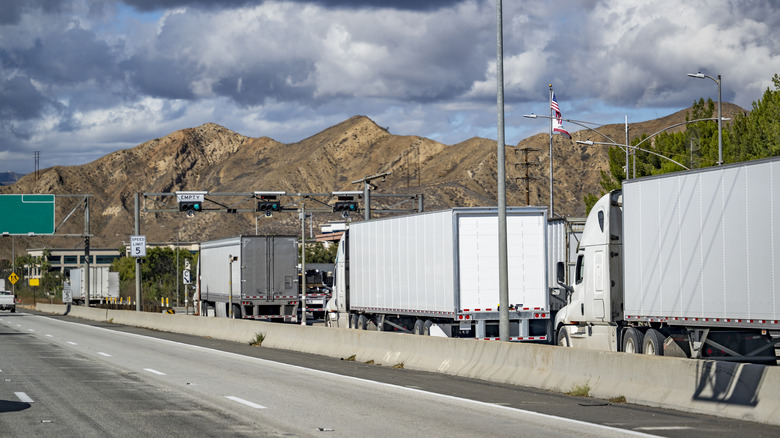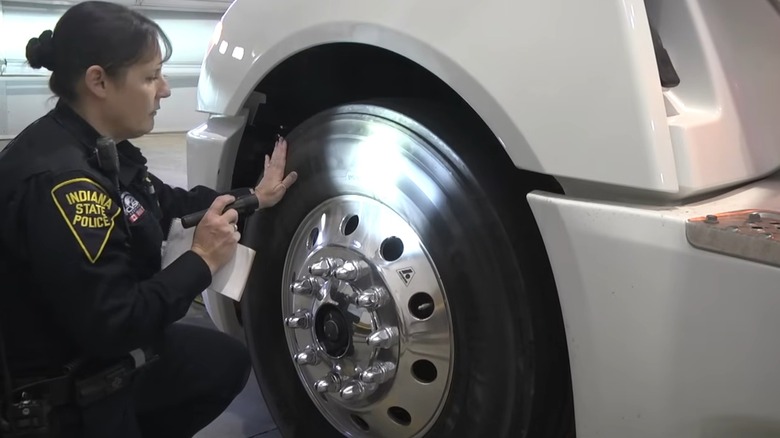How Are Semi Trucks Weighed On The Road? The Tech Behind Weigh Stations Explained
In 2022, trucks transported over 72% of American freight in terms of overall weight, according to the American Trucking Association. In fact, if all long-haul semi drivers suddenly stopped working, Business Insider reports it would be 3 days before grocery store shelves would be emptied.
However, unregulated trucks overburdened with too much cargo contribute to quicker deterioration of roads and pose a safety risk to other motorists. Both stopping distance and maneuverability suffer with a semi loaded over the limit. Each state has weight limits imposed based on how many axles are present, certain restrictions on areas like bridges, and overweight exemptions in specific circumstances.
One of the ways authorities discourage overweight trucks is weigh stations, typically located along the highway, which have massive scales. There are different types of scales employing mechanical or electric technology. Some are level with the ground using a pit design, others sit above ground, requiring the semi to stop at an elevated platform, while others are portable. The Massachusetts State Police, speaking with CBS News, admitted that some drivers looking to skirt the law know where the permanent weight stations are and avoid them. As a result, the agency has experienced a lot of success with portable scales, popping up in commercial districts unannounced.
Industrial truck scales and weigh-in-motion pads
A semi truck scale consists of various components such as the weighbridge, load cells, and a junction box. The weighbridge is essentially the platform the truck drives onto for weight readings and can be made with either steel or concrete. Load cells are the sensors underneath the weighbridge that measure downward pressure. The junction box is a central hub that collects the electrical compression signals sent from the load cells and calculates a single weight figure for the truck.
In some cases, weigh stations will incorporate weigh-in-motion scale pads, which are installed on the off-ramp right as you exit the highway. These begin collecting data before the truck even reaches the weighbridge and official scale. In response to some truckers navigating around the traditional weigh station using alternate routes, some states like Maryland have installed weigh-in-motion technology into the highway, in what officials refer to as virtual weigh stations. In addition, some locations feature even more sensors that grab data, such as a semi's height, as the truck is cruising along at speed.
Weight stations also examine trucks for deficiencies, and remove ineligible drivers
Department of Transportation (DOT) officials aren't just evaluating every truck's weight, but are also conducting visual inspections of the truck and trailer to identify any damage. Major systems of the vehicle may be tested, such as the lights, tire tread depth, and brakes. The load may also be scrutinized in terms of how it's secured or lack thereof, compelling transport companies to be mindful of how cargo is placed in the trailer.
Similar to a traffic stop, truckers may be asked to show various forms of paperwork, such as permits, driver's license, insurance, and their logbook. The logbook is supposed to contain detailed information about how long the driver was operating the truck. According to the Federal Motor Carrier Safety Administration, truckers are allowed 14 consecutive hours of driving along with other limits designed to keep fatigued operators from getting behind the wheel.
Paperwork that isn't correct or out of date could result in fines or even being removed from service in severe circumstances. That's why it's essential for those starting out in the transportation industry to know what documents and information semi-truck drivers always need to have on hand.


